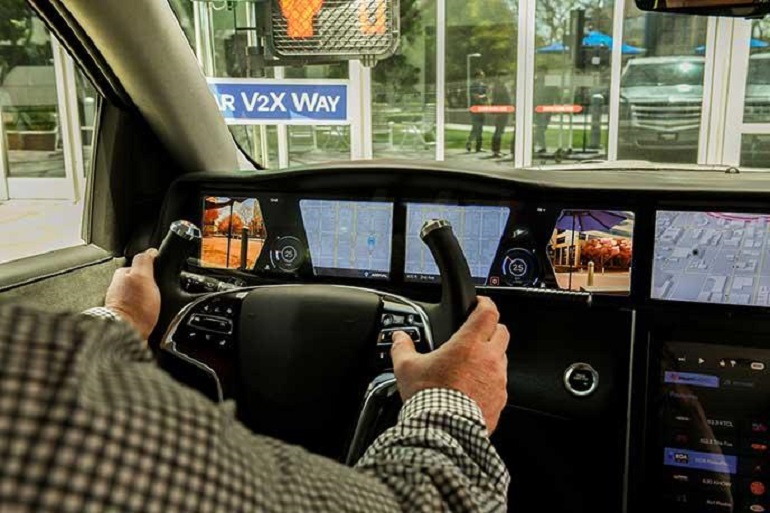C-V2X with support for 5G NR networks: a new paradigm for data exchange between vehicles

5G technologies will make it possible to more effectively collect telemetry data and discover completely new functions for vehicles that can increase road safety and develop the scope of unmanned vehicles. V2X systems (a system for exchanging data between vehicles, road infrastructure elements and other traffic participants) has potential for the disclosure of which 5G NR communication will be used. This will significantly increase the level of safety for drivers, passengers and pedestrians, reduce fuel consumption and travel time.
In March this year, 3GPP, a 5G network standardization organization, approved the introduction of the first C-V2X specifications with support for 5G NR in the next version of the global 5G NR (Release 16) standard. We believe that this version will be adopted in the first half of 2020. The combination of this technology and support for eMBB (ultra-wideband mobile communications), the specifications of which were approved in 3GPP Release 15, will be the first step to using 5G NR to create smart cars based on Qualcomm Snapdragon Automotive Platform.
We do not wait for the global deployment of 5G networks to launch a direct exchange of data between vehicles using cellular communication technologies. Back in 3GPP Release 14, V2X technologies were described that allow cars to exchange basic information with other traffic participants and, for example, traffic lights, at certain intervals. Their capabilities were demonstrated during many tests using our C-V2X chip, Qualcomm 9150. Direct data exchange using C-V2X technologies allows the machine to "see" its surroundings even in situations where other objects are not in direct line of sight, for example, on the blind crossroads or in bad weather. At the same time, new technologies complement and expand the capabilities introduced by other passive sensors, such as radar, LIDAR and camera systems,
The 3GPP Release 16 document and standardization of C-V2X with support for 5G NR will take these capabilities to a whole new level and allow vehicles to receive and send much more information, for example, more detailed data from sensors and information about the “intentions” of road users, about road infrastructure and about the movements of pedestrians. Moreover, the exchange of information about the "intentions" will help to more effectively plan the route of the car, which is important for the development of unmanned vehicles in the future. The C-V2X will evolve from a technology that, in Release 14, served primarily as a means of improving basic road safety, into a tool for direct interaction between traffic participants, which will help increase traffic safety and traffic awareness, as well as reduce fuel and time consumption. the road.

Taking full advantage of the C-V2X and 5G NR
C-V2X solutions based on 5G NR use the innovative capabilities that appeared along with 4G and 5G networks for their work. The first version of 5G networks, which will begin to be introduced this spring and was standardized in 3GPP Release 15, introduced a scalable channel frequency grid step, which is also used for C-V2X. One example of its application is the ability to change the density of the reference signal depending on the speed of the vehicle. According to our estimates, the spectral efficiency at high speeds in this case will grow by 3.5 times, which is extremely important for new scenarios for using the C-V2X, for example, for the exchange of large amounts of data from sensors between cars and road infrastructure elements.
Implementations of C-V2X with support for 5G NR involve several major improvements at the radio level, unique to 5G NR. In Release 16, for the first time in the 5G standard, a “side” communication line will be added - a direct data exchange channel for V2X systems. This technology will serve as the basis for the development of future solutions using 5G NR in smartphones and in other areas, for example, in public safety. The basis for its creation was the development of Qualcomm Technologies for LTE Direct, which in fact led to the appearance of C-V2X technologies in 3GPP Release 14. Also, the technologies described in Release 14 will allow cars with support for an older version of C-V2X to exchange data on the road even with the latest models that use C-V2X of both versions (from Release 14 and Release 16 with support for 5G NR).
A new paradigm of data exchange between vehicles
In the modern paradigm of data exchange using mobile networks, devices change signal transmission parameters, such as its modulation and encoding, depending on the signal quality of the base stations. With the C-V2X, the task is complicated by the fact that we are talking about constantly moving vehicles, and not about stationary base stations. In this case, signal quality alone is not enough to understand which vehicles are suitable for exchanging data in each case. Imagine a car at an intersection around the corner. The signal level is weak, but the car itself is close enough, that is, it is part of the environment that is important for our car. Therefore, both vehicles in this case should be able to receive complete information from sensors regardless of whether
And this in turn means that we need a new paradigm that will take into account not only the signal level, but also the distance between objects. Because of this, the approach to developing 5G networks is different from how the networks of previous generations were built. In particular, at the "lower" levels of 5G NR (physical and MAC levels), there is a need for distance estimation. For example, vehicles will forward acknowledgments, such as automatic ACK / NAK retransmission requests, only if they are within a certain distance from the transmitter and only if the transmitted information is useful to that vehicle. This approach will help to cope with the problem of the "hidden node" in the form of the car described above with a weak signal level, which is around the corner.
5G NR-based C-V2X - more than just data transfer technology
The decision to include C-V2X specifications with 5G NR support in 3GPP Release 16 will be an important step in standardizing modern data transfer technologies that meet the automotive industry's requirements for new vehicles, including unmanned vehicles. In addition to data transmission methods, we also conduct research and standardize higher level protocols and message transfer methods in regional standards such as SAE, ETSI ITS and C-ITS. These standardized messages will enable vehicles of different manufacturers to take full advantage of the new C-V2X technology. Like the C-V2X described in 3GPP Release 14, C-V2X solutions with 5G NR support will mainly use the 5.9 GHz band, which is allocated for vehicles in many countries around the world, for example, the USA, Europe and China.
